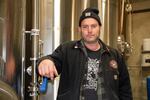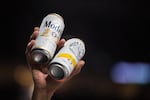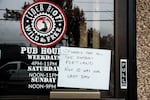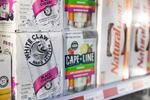After Cider Riot served its final drink in November, founder Abram Goldman-Armstrong pulled the bric-a-brac off the walls. Closing the Portland cidery was sad work.
It’s not that people disliked his hard cider. In fact, it won awards.
“Great accolades, but accolades don’t go in the bank account,” he said.

Cider maker Abram Goldman-Armstrong in his former production facility in Portland, Ore., Nov. 12, 2019. His cider won awards, he said, "but accolades don't go in the bank account."
Kate Davidson / OPB
Cider Riot gained notoriety last spring as the site of a street clash between members of Patriot Prayer and antifa activists who frequented the pub. Officials called it a riot.
But violence at the door didn’t hurt business either, according to Goldman-Armstrong.
More like big dreams and hard seltzer.
“The tidal wave of White Claw, really,” he said.
White Claw is the leading hard seltzer, an alcoholic upstart that's exploded in growth and changed the face of your local beer case. Retail sales of hard seltzer increased more than 200% for the year ending Nov. 30, reaching almost $1.5 billion, according to the research firm Nielsen.
That growth has squeezed some cider makers like Goldman-Armstrong, who rely on sales in stores as well as on tap.

A vendor holds up a Modelo Especial beer and a White Claw hard seltzer during a National Basketball Association game between the Portland Trail Blazers and the Toronto Raptors at the Moda Center in Portland, Ore., Wednesday, Nov. 13, 2019. The Moda Center began selling White Claw in 2019.
Bradley W. Parks / OPB
The thing is, cider makers have seen this play before.
"It's been a wild ride," said Michelle McGrath, the Portland-based executive director of the American Cider Association. "So when people are standing back and saying, 'Wow. Hard seltzer's growing really fast.' That was cider not too long ago."
Cider’s Wild Ride
Abram Goldman-Armstrong was in college when he made his first batch of homebrew cider.
“Got a bunch of apples from the dining hall and a cheese grater and two plates,” he said. “That was my first apple press.”
He started Cider Riot in his garage in 2013. Back then, cider was booming, barreling down the path from niche industry to what the Cider Association calls a billion-dollar market.
“The cider industry is ten times today what it was a decade ago,” said McGrath. “There are over a thousand cider producers and a decade ago there were under a hundred.”
“We were basically doubling our sales every year,” said Goldman-Armstrong.
To keep growing, he needed more room. He had seen other cider makers outgrow their facilities, so he took a risk. He made a big investment in a big new space – part pub, part production. But he may have dreamed too big.
“When we built this facility, we were saying, ‘OK, great. We’re going to be making 2,000/3,000 barrels of cider a year.’” he said.
Instead, he hit 1,000 barrels – about a quarter million pints – and stalled. It was a money-losing spot and a classic mistake: betting that the growth you see now is the growth you’ll see tomorrow.

Portland cidery Cider Riot on Nov. 12, 2019, soon after it closed. Cider maker Abram Goldman-Armstrong said the explosive growth of hard seltzer hurt the distribution side of his business.
Kate Davidson / OPB
The market changed. Hard cider’s explosive growth pumped the brakes and a more nuanced picture emerged.
Cider sales at chain stores and other off-premise retailers shrank about 4% for the year ending Nov. 30, according to Nielsen. McGrath said regional cider brands continued to grow – albeit more slowly – while declining sales of national brands drove overall numbers down.
Oregonians tend to prefer regionally produced cider, but that doesn't mean local cider makers are immune from market pressure. People in the cider industry now talk about “sustainable growth” and “headwinds.”
All this as a new force swept corner stores.
"Ain't no laws when you're drinking Claws, baby" hollered comedian Trevor Wallace in a viral video spoofing the 100 calorie, hard seltzer powerhouse White Claw. Consumers are drinking staggering amounts of the low-calorie, low-carb refreshment.
“I mean, if you think about it, La Croix, it’s just a virgin White Claw,” Wallace also said.
The New Thing In Beer
The rise of White Claw has led to a turf war in your local beer case.
Just walk over and take a look. McGrath said you’ll see a section for non-beer items, “including cider. Including hard soda, including hard kombucha, including hard coffee, hard tea and hard seltzer.”
Those drinks compete for space. So as stores stock more hard seltzer, something’s got to give.
“And right now that something appears to be cider,” she said.
Sean Brill, the manager of a Plaid Pantry in Southwest Portland, agreed.
“It’s just exploded,” he said of hard seltzer. “It’s gone from nothing, no one really talked about it, to 'this is the new thing in beer'.”

Plaid Pantry president and CEO Jonathan Polonsky at a southwest Portland, Ore., store on Nov. 15, 2019. Polonsky said shelf space for hard cider has been compressed to make way for more hard seltzer.
Kate Davidson / OPB
Plaid Pantry’s president and CEO Jonathan Polonsky said he expects shelf space for cider will shrink even more this spring. The chain used to carry a 6-pack made by Cider Riot, but Polonsky said it didn’t sell well. It was put on clearance to make way for hard seltzer.
“The distribution side just got really kicked in the teeth,” said cider maker Goldman-Armstrong.
Even beer appears vulnerable to the tidal wave of White Claw.
At Fred Meyer, the White Claw variety pack has now surpassed long-reigning champion Coors Light, to become the number one seller in beer, wine and spirits.
“By a long shot,” said adult beverage manager Shannon Malloy.
She said that doesn’t necessarily mean cider has shrunk at Fred Meyer stores. That decision depends on what customers at each location want to buy.
(Some) Cider Does Seltzer
Looking back, Abram Goldman-Armstrong said he should have aimed smaller for Cider Riot. But as he dismantled the cidery in November, apple crates stacked out back, he could barely hide his scorn for hard seltzer.
“It’s disturbing, because we come from someplace that was renowned for craft,” he said. “That was renowned for flavorful, locally made beverages. And now we’re seeing this … fermented sugar.”

Hard seltzer lines store shelves at a Plaid Pantry store in southwest Portland, Ore., Nov. 15, 2019.
Kate Davidson / OPB
Other Northwest cider makers are taking more of a if-you-can’t-beat-them-join-them approach. Brands controlled by or affiliated with Reverend Nat’s Hard Cider, 2 Towns Ciderhouse and Seattle Cider Company have all introduced their own hard seltzers.
“It was a real fun technical challenge,” said Portland cider maker Nat West of the hard seltzer he just released under his Cascadia brand. It’s an experiment the “Nat” of “Reverend Nat’s Hard Cider” wouldn’t have tried if seltzer weren’t taking a bite out of sales.
“There are a lot of fun technical challenges out there I’m not tackling,” he said.
The difference between his product and White Claw, he added, is that much of the fermented sugar in it is derived from Northwest apples and beets.
Meanwhile, cideries continue to open or expand around the region, including Rain Barrel Ciderworks in Baker City and Alter Ego Cider in Portland.
As the new year dawned, Abram Goldman-Armstrong had news of his own: another local cidery had agreed to produce four of his ciders.
“At least the brand lives on,” he said.
And as long as people drink seltzer, hard seltzer likely will too.
